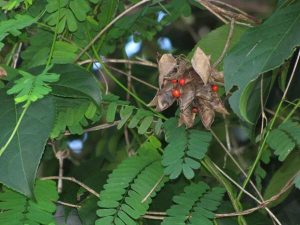Abrus precatorius (Gunja) also known as Jequirity, Crab’s Eye, Rosary Pea, John Crow Bead, Precatory bean, Indian Licorice, Akar Saga, Giddee Giddee or Jumbie Bead and raati (for seed)
Parts used – Root, seed and leaves
Uses – The root, seed and leaves of Gunja is used in the form of powder to treat vabahuka (frozen shoulder), gandamala(scrofula), dental caries, baldness, dandruff, for promoting growth of ear lobes, erysipelas and skin diseases.
Dental caries – Root of gunja made into a paste is applied on affected parts (5-10 gms). It relieves the pain caused by dental caries (RM.5.13)
Dandruff – Oil cooked with gunja seeds along with bhrngaraja(Eclipta alba) in case of itching, dandruff and other diseases of scalp (10-15 ml)(VM.57.70)
Abrus precatorius, whose common names are, Jequirity, Crab’s Eye, Rosary Pea, John Crow Bead, Precatory bean, Indian Licorice, Akar Saga, Giddee Giddee or Jumbie Bead.
This plant is high-climbing, twining, or trailing woody vine with slender herbaceous branches. Leaves alternate, petioled, 5-13 cm (2-5 in) long, even-pinnately compound with 5-15 pairs of leaflets, these oval to oblong, to 1.8 cm (< 1 in) long, with margins entire. Flowers shaped like pea flowers, white to pink or reddish, small, in shortstalked dense clusters at leaf axils. Fruit a short, oblong pod, splitting before falling to reveal 3-8 shiny hard seeds, 6-7 mm (< 1 in) long, scarlet with black bases.
The plant is considered poisonous, particularly the seeds. Hence a process of detoxification is considered absolutely necessary to remove toxicity of seeds. The process involves boiling of pounded seeds in kanji or cow’s milk for 3 hours. Heat-denatured abrin looses its haemagglutinating toxicity. Research groups has done some outstanding research on retention of the immunomodulatory activity of heatdenatured or tryptic-digested abrin, while loosing toxicity. Once again an ancient insight on Abrus precatorius and its usage has been validated by state – of – the – art relevant science. This has been the path of major advances in pharmacology, by studying the mechanisms of action of poisons egergot, calabar beans, curare etc.
Dried Leaf of this plant is Anti-spasmodic, Dried Seed is Anthelmintic, anti-diarrhoeal, and inhibits intestinal motility. Fresh Root are used as Anti-convulsant and uses as Anti-bacterial, anti-spasmodic, insecticide.
In Ayurveda Abrus precatorius is used as following:
Leaf: Alexiteric, astringent, diuretic, emetic, sweet.
Root: Abortifacient, alexiteric, anthelmintic, anti-septic, astringent, diuretic, emetic, sweet.
Seed: Abortifacient, acrid, aphrodisiac, astringent, bitter, febrifuge, purgative, toxic, trichogenous.
Traditionally, the seed of Abrus precatorius (ratti) was used to weigh gold, pearls and precious stones.

One other important part is that if you are an older person,
travel insurance for pensioners is something that is important
to really take into account. The old you are, greater at risk you will be for
making something poor happen to you while in foreign countries.
If you are definitely not covered by many comprehensive insurance coverage,
you could have many serious problems. Thanks
for discussing your hints on this blog.
good inf……